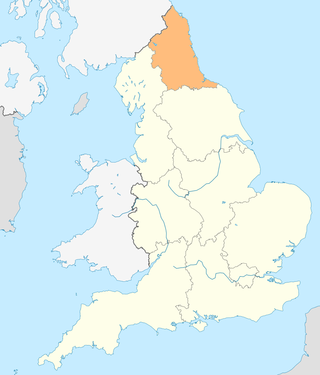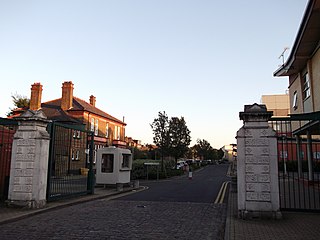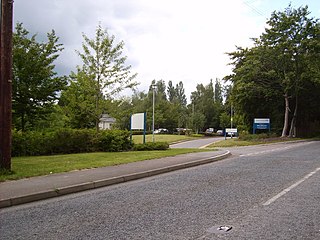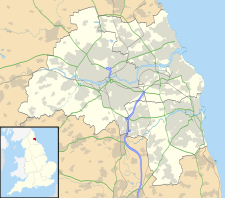
Sunderland is a port city in Tyne and Wear, England. It is the City of Sunderland's administrative centre and in the historic county of Durham. The city is 10 miles (16 km) from Newcastle-upon-Tyne and is on the River Wear's mouth to the North Sea. The river also flows through Durham roughly 12 miles (19 km) south-west of Sunderland City Centre. It is the only other city in the county and the second largest settlement in the North East after Newcastle upon Tyne.

Sunderland, commonly known as the City of Sunderland, is a metropolitan borough with city status in the metropolitan county of Tyne and Wear, England. It is named after its largest settlement, Sunderland, spanning a far larger area, including nearby towns including Washington, Hetton-le-Hole and Houghton-le-Spring, as well as the surrounding villages and hamlets. The district also forms a large majority of Wearside which includes Chester-le-Street in County Durham.

Fulwell is an affluent area and former civil parish in the City of Sunderland. The parish was abolished in 1928 as a result of the Sunderland Corporation Act 1927, and the area incorporated into the former County Borough of Sunderland. It borders Seaburn, Southwick, Monkwearmouth, and Roker, and the district border between Sunderland and South Tyneside. Fulwell ward, including South Bents and Seaburn, is the least socially deprived of the city's 25 wards.

The Countess of Chester Hospital is the main NHS hospital for the English city of Chester and the surrounding area. It currently has 625 beds, general medical departments and a 24-hour accident and emergency unit. It is managed by the Countess of Chester Hospital NHS Foundation Trust, one of the first Foundation Trusts in the UK, formed in 2004. Cardiac rehabilitation services at the hospital are provided by Cheshire and Wirral Partnership NHS Foundation Trust.

The Royal South Hants Hospital, known locally as "The RSH", is a community hospital in Southampton. It is managed by NHS Property Services.
Southwick is a former village and now a suburb on the north banks of the River Wear in the city of Sunderland in the county of Tyne and Wear, historically in County Durham. From 1894 to 1928, Southwick was administered by the Southwick-on-Wear Urban District Council, before being absorbed by Sunderland.

Stobhill Hospital is located in Springburn in the north of Glasgow, Scotland. It serves the population of North Glasgow and part of East Dunbartonshire. It is managed by NHS Greater Glasgow and Clyde.

The North East Ambulance Service NHS Foundation Trust (NEAS) is an NHS foundation trust responsible for providing NHS ambulance services in North East England. Headquartered in Newcastle upon Tyne, NEAS provides emergency medical services to the metropolitan boroughs of Newcastle upon Tyne, Gateshead, North Tyneside, South Tyneside and City of Sunderland; the ceremonial counties of County Durham and Northumberland; and the area of North Yorkshire commonly known as Teesside. NEAS was formed on 1 July 2006, following the merger of the existing North East Ambulance Service with the Tees division of the Tees, East and North Yorkshire Ambulance Service (TENYAS). Northumbria Ambulance Service and County Durham Ambulance Service had previously merged on 1 April 1999.
Radio Sunderland is the hospital radio station for Sunderland Royal Hospital and the St Benedict's Hospice in the City of Sunderland, England. On the air since 1953, the station provides music, entertainment and information for patients. Since August 1998 the station has been broadcasting continuously 24 hours a day.

Lanchester Road Hospital is a mental health facility located in County Durham, England, and lies on a large site just north west of Durham city. It is managed by the Tees, Esk and Wear Valleys NHS Foundation Trust.

St Nicholas Hospital is an NHS psychiatric hospital located in Gosforth, Newcastle upon Tyne, England, UK. The entrance is located on Jubilee Road. The buildings range from Victorian-era to modern facilities and occupies 12 hectares of land. It is managed by Cumbria, Northumberland, Tyne and Wear NHS Foundation Trust.

Lambeth Hospital is a mental health facility in Landor Road, South London. It was previously known as the "Landor Road hospital" and is now operated by the South London and Maudsley NHS Foundation Trust and is affiliated with King's College London's Institute of Psychiatry. It is also part of the King's Health Partners academic health science centre and the National Institute for Health and Care Research (NIHR) Biomedical Research Centre for Mental Health.

In 685, King Ecgfrith granted Benedict Biscop a "sunder-land". Also in 685 The Venerable Bede moved to the newly founded Jarrow monastery. He had started his monastic career at Monkwearmouth monastery and later wrote that he was "ácenned on sundorlande þæs ylcan mynstres". This can be taken as "sundorlande" or the settlement of Sunderland. Alternatively, it is possible that Sunderland was later named in honour of Bede's connections to the area by people familiar with this statement of his.

Cumbria, Northumberland, Tyne and Wear NHS Foundation Trust is one of the largest mental health and disability Trusts in England employing more than 7,000 staff, serving a population of approximately 1.7 million, providing services across an area totalling 4,800 square miles. It works from over 70 sites across Cumbria, Northumberland, Newcastle, North Tyneside, Gateshead, South Tyneside and Sunderland. It also has a number of regional and national specialist services.

Stratheden Hospital is currently a small community hospital in Stratheden, Cupar, Fife which was originally called Fife and Kinross District Asylum. Its name was changed to Stratheden Hospital in 1948. It was a centre of excellence in Child and Family Psychiatry from the 1960s. In the 21st century, it caters for psychiatric health. It is managed by NHS Fife.

Tatchbury Mount Hospital is a health facility to the north of Totton, Hampshire, England. It is owned and managed by Southern Health NHS Foundation Trust and acts as the Trust's headquarters. The site was formerly a large psychiatric hospital with the majority of the buildings on the site dedicated to this purpose, however in recent years changes in the management of these patients has resulted in the uses for the site diversifying.

The NHS Nightingale Hospital North East was one of the temporary NHS Nightingale Hospitals set up by NHS England to help to deal with the COVID-19 pandemic. It was constructed inside the Centre of Excellence for Sustainable Advanced Manufacturing, Washington.

St Benet's Church is a Catholic church in Monkwearmouth in Sunderland. It was built in 1889 and designed by Archibald Matthias Dunn and Edward Joseph Hansom. It is located on the corner of Thomas Street North and George Street North, half a kilometre east of the Stadium of Light. From 1900 to 2011, the Redemptorists served the parish. The church is now once again served by priests from the Diocese of Hexham and Newcastle. When it was built, it was the first Catholic church in Sunderland to be built north of the River Wear in the nineteenth century.



















